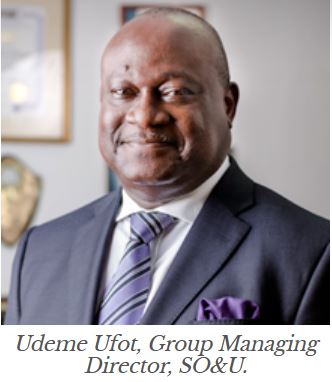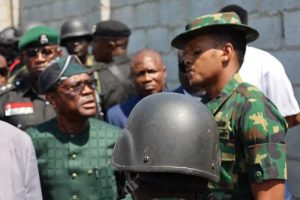
Credit: SO&U
A Presentation at the Destination Branding Masterclass of the National Advertising Conference 2025.
Udeme Ufot
Group Managing Director
SO&U
14th November, 2025.
Distinguished industry leaders, ladies and gentlemen,
Let me thank the organizers of National Advertising Conference 2025 for the opportunity to speak to you today. It is a pleasure to share my thoughts on a topic that stands at the intersection of marketing, leadership and national identity. It is an area I have had the privilege of experience having been involved at different levels in two of Nigeria’s most successful destination branding programs. In both, strong lessons are to be shared as to how leadership at the highest levels of the state or nation is critical to success of destination branding.
Introduction
In thinking about destination branding, what tends to come to mind for many people is glamorous print advertising and television commercials showing exotic images of destinations.
Destination branding goes beyond that.
It is about capturing the essence of a destination, crafting a differentiating promise
around it, and delivering same through strategically crafted narratives to create and manage a perception that guides what people think, feel and believe about the destination.
Building the destination brand starts with a consensus of what the people want to be known for, a reality they are committed to living and which they demonstrate in their daily interactions.
Creating an attractive destination brand offers tremendous rewards. It becomes a destination for investments, conferences, exhibitions, and leisure travel. Above and beyond that, it confers a form of soft power as the country gains more respect and influence in the comity of nations and its people have a more heightened sense of nationhood and pride.
Even goods manufactured in the country and services rendered can benefit from more premium pricing, while the country itself becomes more resilient to crisis.
The three most attractive destinations in Africa are noted as Johannesburg, Marrakesh and Hurghada in Egypt.
According to Road Genius, a travel site, Johannesburg attracted 4.12 million visitors in 2024 who spent over $303m in the month of December alone. Marrakesh in Morocco attracted 2.8million visitors who spent $11.3billion in 2024.
Compared to above figures, Nigeria attracted $1.8billion in tourism revenue in 2023 and just above $2billion in 2024.
Projections by Lagos State Government, driven by the opportunities offered by Detty December, is that revenues from tourism in 2025 could hit $3.45billion and rise to $3.75billion in 2027.
Growth of tourism in Africa over the next three years is projected at 8% year on year with revenues projected to exceed $90billion by 2027 according to the World Trade and Tourism Council (WTTC).
To benefit from this opportunity, we must strategically market our destination in a way that will attract the best of conferences and a large number of fun seeking leisure tourists, including diaspora Nigerians. Despite accounting for 18% of African GDP, over 200million consumers, and offering some of the largest delegations at African conferences, we capture less than 2% of Africa’s conference economy.
We have all that is required to make a difference. All we need is the commitment at the leadership level create the enabling environment on which an attractive destination brand can be built.
Imperatives for Building a Strong Destination Brand.
Visionary and Committed Leadership
Brand perceptions are built on the essence of products that are created or carefully curated to support desired perceptions. For destination branding, there must be elite consensus on what they want their City, State or Country to represent. Once this is agreed, it is up to the leadership to set the agenda, engage stakeholders and drive the agenda through demonstrated commitment to the ideals.
No destination brand can thrive without strong leadership. Leadership provides direction, continuity and conviction. Around the world, great destination brands like “Incredible India”, “Malaysia, Truly Asia”, “Amazing Thailand”, all had one thing in common: committed political leadership that stayed the course.
Two of the most successful state destination branding projects I have had the privilege of working on had the Governors as Chief Marketing and Sales Officers of the states.
In 2015, Governor Udom Emmanuel of Akwa Ibom State launched the Dakka Da initiative. “Dakka Da” means stand up, and it was a call to action for the people to jettison the image of a laid back agrarian and civil service state and “Rise to the Faith of Greatness”. This was encapsulated in the Dakka da Creed, personally crafted by the Governor. It was a call to rise above limitations, to realize their God-given potential for greatness and to take pride in their identity.
Every public speech the Governor gave had elements of the Dakka Da Creed inserted leaving nobody no doubt as to the seriousness the governor accorded the program.
Carnival Calabar, was driven by Governor Donald Duke’s passion to redirect the outbound Nigerian elite to Calabar for Christmas. He believed he could offer better “Christmas lights” and fun than any European capital. All briefings were directly handled by him and all presentations received by him, even if it meant late night presentations.In executing the brief, he led from the front by leading his own Carnival Band on the streets of Calabar, accompanied by his wife. Budgets were tight, but his personal commitment and salesmanship saw the carnival through during his tenure.In both Dakka Da and Carnival Calabar, the Governors were not only integral to conceptualizing the destination branding concepts, they were the Chief Marketing and Sales Officers of both initiatives. They modeled what they expected of every citizen as regards the program.
With such passionate commitment, there was no way the initiatives would not succeed.
Deep Knowledge of the Target Audience
There are two key audiences involved in crafting your strategy for destination branding.
The local audience who will contribute to building the brand by their actions.
The external audience to which the brand would be sold.
For the brand to be sustainable, the imagery and communication must be authentic and connected to the history, culture, attributes and experiences of the people. For instance, the destination branding for Cross River State had its roots in the culture, food and folklore of the people. Tinapa was a mythical place of enjoyment in Efik folklore.
The Carnival Calabar and Street Parade was simply an amplification of what people in Calabar were used to during the yuletide season. It was now being amplified, glamourized and targeted at an external audience.
It was imperative that Cross Riverians were sold on the concept and would commit to playing their part in the transformation of Calabar to Nigeria’s premier Christmas holiday destination.The communication also needed to understand the expectations of the immediate external audience (Nigerians from other states) who would travel outside their locations to seek a fun filled holiday wherever they could find it. They were known to spend millions to visit London in the cold of winter to see the Christmas lights of London or join the New Year countdown in Times Square New York.
Define a Clear Promise
The destination strategy needed to offer the audience something they could look forward to. Carnival Calabar curated a month long series of fun experiences across the state, that climaxed with the Street Carnival and Parade.
Working in partnership with tour managers, packages were created to take visitors beyond Calabar to Obudu Resort, Tinapa, the Forest Reserves, wildlife sanctuaries and the various waterfalls, and historical sites. Engagement of the citizenry turned Calabar into one big fun location through the month of December as everyone contributed to create a fun experience. Cross River State promised visitors “Africa’s warmest welcome” and rehashed an old acronym for Calabar “Come And Live And Be At Rest”. In support of this acronym government offices in Calabar stopped work end of November and resumed in January.
Consistency of Narrative
A consistent narrative with effective utilization of storytelling, visuals and amplification of experiences is critical for impact. Leveraging and glamorizing old images as well as folklore of Calabar gave the narratives greater authenticity.
Everything was done to project an image of fun, enjoyment, colour and glamour that could not be found anywhere else in Nigeria.
Leverage Local Identity
It helps to be authentic in imagery and messaging whether in terms of culture, cuisine, historical sites, people, music and theater. Amplifying and glamourizing what people are already familiar with helps believability and resonance.
For Carnival Calabar, many Nigerians were already quite familiar with “Ojuju Calabar” and could therefore relate easily to a festival of masquerades, colorful dancers and street parties in Calabar.
Calabar had also been identified for good cuisine and it was not difficult to credibly link this to the celebrations. The place was also known for peace, security and cleanliness thus minimizing risk exposure.
Cross Sectoral Collaboration Amongst Stakeholders
The brand is built through engagements at various touchpoints. Policy makers, business leaders, the creative industry, media and the citizenry have roles to play. Mass mobilization across stakeholder segments is critical to consistency of experience and success of any destination branding if it must be sustainable.
When Dakka Da was launched it was to a packed stadium with all representatives of the state’s citizens in attendance from across all Local Governments. From youths to market women, clergy and the business community, civil servants and the political elite, the objectives of the branding exercise were clearly articulated and presented to all in attendance. The Dakka Da Creed was recited at all public events after the National and State Anthems. Dakka Da Ambassadors were identified and appointed to take the message down to the Local Governments and grass roots, supported by intensive and penetrative communications on radio.
A key success factor of the project was the clergy. Having understood the role of the church in a mainly Christian State, a lot of the communication leveraged biblical injunctions that resonated with the people. Within three weeks of program launch, Dakka Da was part of the content of Sunday sermons by Pastors, even in the villages.
Experience Delivery
The brand must remain true to its promise. It is therefore critical that all elements of the brand that will interact with the target audiences must be familiar with the brand promise. Sensitization of the public to play their part is critical to ensure that visitor experiences align with communication.
Every visitor to Calabar in the days of Donald Duke acknowledged the warmth with which they were received. The mood on the streets was truly joyful and welcoming of visitors. Locals created their own activities to add to the fun. Visitors returned to their various locations and talked about the experience. Word of mouth took over and Calabar became the Christmas destination for many Nigerians.
Measurement and Adaptation
Metrics are key to measuring success of the branding program. It could be based on awareness measures, compliance to ideals of the program. Better still, it could be measured by the number of visitors, revenue from the visitors or FDI that is attracted during or immediately after the campaign.
Being able to present positive performance metrics is the greatest sustainability plan for the program. The client needs to be assured of value for money spent.
Performance metrics also inform if the program requires adjustments in certain areas to inform reviews and adaptations.
Continuity
It takes time and consistent messaging to build a sustainable brand. It should be expected that with elite consensus through which the brand ideals are identified and with sufficient stakeholder engagement, the program should survive regime change. It rarely does. Even when it survives, commitment of the new leadership may not be as strong. Dakka Da was folded into ARISE on the assumption of a new Governor in Akwa Ibom State. Governor Duke’s successors have not matched his passion in promoting Carnival Calabar.
Conclusion
Effective and sustainable destination branding requires a long term strategy that weaves together infrastructure, policy, culture, history and communication. Our leaders must understand that we cannot continue to reset the dial every time a new administration assumes office if we really want to build a strong and sustainable brand.
Destination branding is not the jingles, not the advertising campaign, but a journey towards a desired perception that demands vision, conviction, collaboration and investment on a long term.
When done right, it can transform how the world sees us, engender greater respect, and boost national pride. We have seen it work in Cross River, Akwa Ibom and internationally in Rwanda, Dubai, and now Saudi Arabia.
Detty December offers us a great opportunity for destination branding that is intrinsic to Nigeria. It is up to us to mobilize and partner with our creative industries to take full advantage of this opportunity. Government’s commitment to invest in infrastructure, mobilize the people and drive policies to upscale the experience of the visitors will position us to optimize the potentials inherent in Detty December.
Thank you for your attention.



